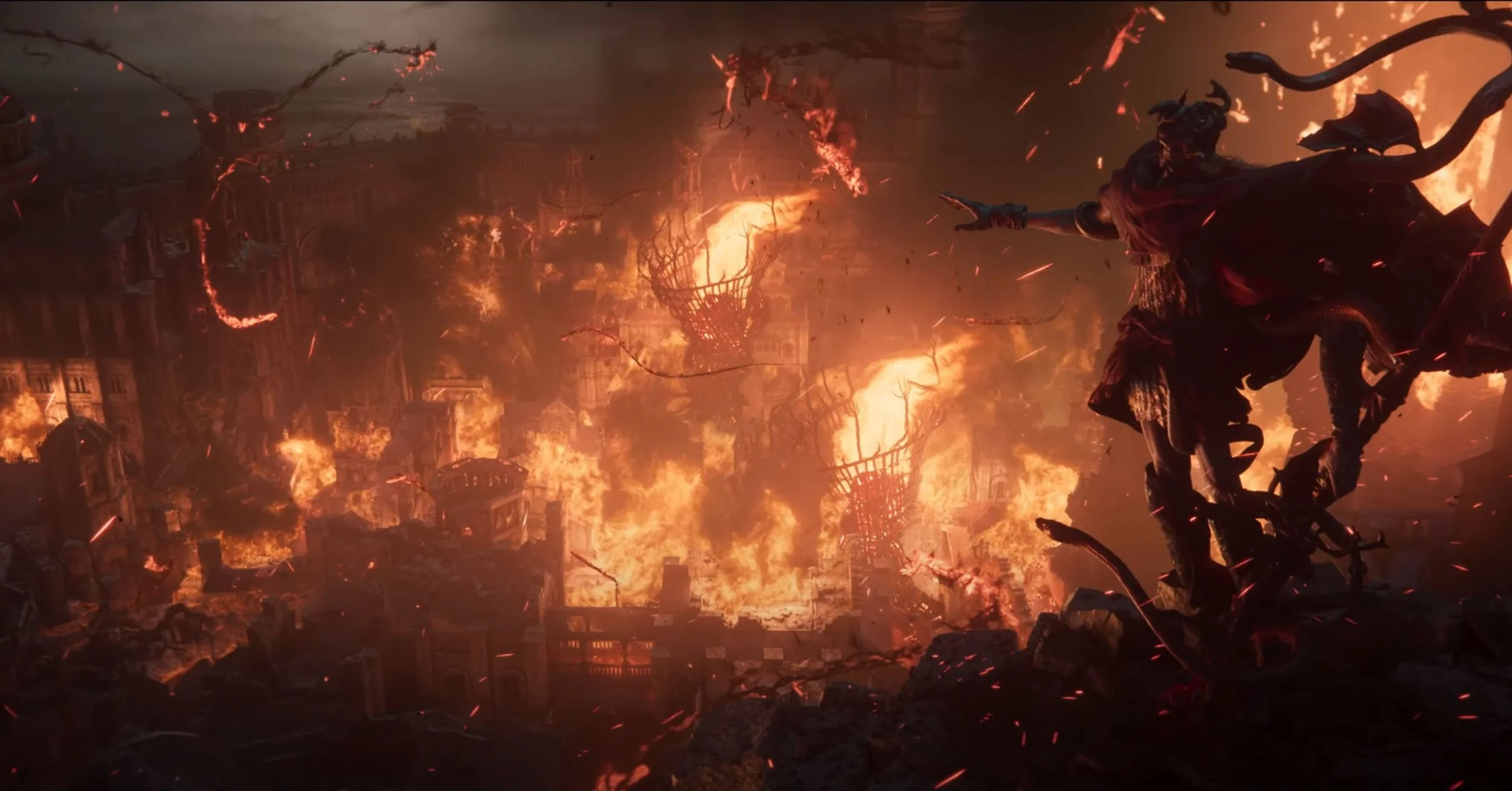Discount for review copy provided by Chip Theory Games
Too Many Bones is a monstrous adventure game from Chip Theory Games in a genre new to most tabletop gamers—the dice-builder roleplaying game. Designed by Josh and Adam Carlson, it’s a solo or cooperative experience that will surprise many with its depth of design and attention to detail in both gameplay and component quality. It’s the kind of game to break out when your friends are over to impress them with the neoprene mats and custom dice, but it’s also a remarkably challenging and engaging adventure that will provide hours of fantasy roleplaying and character progression.
Whether you’re fighting regular Baddies or imposing Tyrants, each battle bears weight and consequence, and navigating the treacherous land without getting knocked out or killed is difficult. If you’re looking for the next big campaign to dominate the table, then this could be it. But before all of that, let’s peer into the Deepwood and see what’s happening in the world of Too Many Bones.
STORY
Your race has lived hidden in the Deepwood for centuries, and only recently, your kin has been forced to emerge to the south and take shelter within the walls of Obendar. Due to your reclusive lifestyle, many in town are encountering your race for the very first time. Some locals believe you to be an elf, due to your distinct facial features; others would say a goblin, from your size and build. Others still would insist your high technological aptitude proves you a gnome! Only those most intimate with the Deepwood know your true kind and kin as Gearlocs – big-eared, thin-bodied creatures with conflicting loves of nature and machine and an insatiable thirst for adventure!
GAMEPLAY
One to four players will journey together in this campaign. The base game provides four classes of Gearlocs to play with, but expansions can increase that number to give players more choices for their adventuring party.
Each Gearloc will have their own custom playstyle and dice set, though, and tabletop gamer will have to learn each one thoroughly to gain an understanding of strategy and the best approach to combat. Proceeding through multiple days of the journey, a game will consist of multiple battles before reaching the Tyrant. Along the way, encounters will force the party to make decisions every day on whether to fight, whether to rest, and other important choices that will affect the outcome of the game.
Too Many Bones combines storytelling with tense combat. Each moment could result in a spectacular victory or crushing defeat.
So how does the game work?
Play progresses through daily Encounters as the Gearloc party earns Progress Points to fight their way to the Tyrant. Each day moves through four different phases—New Day Phase, Encounter Phase, Reward Phase, and Recovery Phase.
New Days mark the passage of time, but the Encounter Phase is where players will spend most of their time. These are the general, special, and tyrant-specific events that will confront the Gearlocs with decisions. Each encounter has two options, and whichever one the party chooses will provide certain rewards.
Those rewards might consist of avoiding battles, earning Training Points, gaining Loot, or skirmishing with enemies under certain environmental conditions. Whatever the players choose, they will commit to that for the daily Encounter before proceeding to the Reward Phase and Recovery Phase.
That cycle continues until the Tyrant has been challenged and defeated, or until the players either run out of time or all fall in combat.
It’s a relatively simple structure that players will adapt to easily. The complexity lies in the battles with Baddies and Tyrants, as well as the intricacy of each Gearloc and how to extract the most advantages in any given combat. That’s where the real strategy of Too Many Bones lurks, and it’s where the game will either win your affection or lose your interest. With that in mind, let’s examine both the Gearloc Mats and Battle Mat since those are the beautiful play areas that will demand so much attention and contemplation.
Each Gearloc plays nothing like the others. Picket is the tank that will absorb a lot of the melee attacks from advancing enemies. Boomer is the fragile ranged fighter that lobs projectiles at enemies for high damage. Patches is the plucky medic that keeps the party fighting even when they’re battered and broken. And Tantrum is the insane berserker with no thought for self-preservation.
With 16 custom dice that provide special Skills beyond ordinary health, dexterity, attack, and defense, the Gearlocs are characters with a lot of personality and a lot of depth. Figuring out which dice-build works to your playstyle is important, and it is part of the experience.
You might very well lose multiple battles or Tyrant fights before discovering the best way to play that combines your tabletop sensibilities with the particular skill set of the Gearloc you’re controlling.
Should you train Boomer all in one skill tree to use Frags, Big Booms, Stunners, and Napalms during a battle or is it more worth it to spread her Skills across the playmat to ensure a well-rounded fighter?
Should we risk building Picket to be an offensive tank rather than a defensive one knowing that our party doesn’t have Patches to help keep everyone alive?
The more you play Too Many Bones, the more you’ll be able to discern the answers to whatever questions you have about the party composition or Gearloc character builds.
And then we should look at the battles in the game, which are laid out and played out on the Battle Mat, which is a spatial puzzle and combat nightmare that players will learn to love and hate.
Melee and ranged fighters start on different positions but can move once the battle starts, and each combatant has a particular Initiative that will determine the order in which they fight. So roleplaying veterans will be familiar with that turn-based combat, but the physical mat provides some interesting challenges in shifting around the Gearlocs in order to take advantage of the battlefield and to maximize efficiency when dealing damage and defending against enemy attacks.
It’s a complex dance that will take some time to master, and it’s valuable to understand how best to approach combat with each player’s Gearloc. But it’s equally important to know how each Baddie can complicate the fight with their own Skills that heighten the danger and/or weaken the Gearlocs.
If all of that doesn’t sound like a lot, players will also need to consider when is the best time to implement Loot and Backup Plans to affect the outcome of a battle. For those that aren’t intimidated by all of the problem-solving and cooperative adventurings, then you’ll find a lot to love here.
One thing to consider before playing Too Many Bones, though, is how much time you’re willing to commit to a tabletop game. If you’re like me—and if the reason you’re reading this review is that you love deep strategy games with a lot of moving parts and immaculate design—then there’s nothing to worry about. But Too Many Bones takes at least an hour to play, and the likelihood is that it will take several more. Especially when playing with newcomers who aren’t familiar with the rules or the Gearlocs.
It’s an investment and one that you should be aware of. But it doesn’t detract from the quality of the game nor the enjoyment from winning that seemingly unbeatable band of Baddies or from slowly building your Gearloc into a fearsome adventurer.
VISUALS
Chip Theory Games has introduced a new quality standard in tabletop gaming. The design and production quality of everything in Too Many Bones is insane. What would normally be reserved for exclusive Kickstarter rewards and add-ons are what comes in the base game.
The Gearloc Mats and Battle Mat are thick neoprene surfaces with slots for dice. The cards are plastic. Over 100 custom dice have been included with screen-printed graphics. High-quality chips identify the Gearlocs, the Baddies, the Tyrants, their lane position, and health.
A wonderfully organized box with dice and component trays helps to facilitate easy game setup and cleanup. As well as gameplay with each Gearloc able to organize their play area during an adventure.
Too Many Bones is a game to revel in the beauty of the design, and you want to show it off to friends.
With that comes a price tag to match, but with the increasing price of board games, especially ones launched on Kickstarter, this may not be the obstacle it once was for players.
REPLAYABILITY
Chip Theory Games has already supported Too Many Bones with numerous expansions and add-ons that can increase the replay value of the game.
But the base game itself has a lot to offer. With seven Tyrants, plenty of Baddies, and numerous Encounter cards, each game and each party decision will be different. And each player will have a different experience as they learn the intricacies of the Gearloc they control.
Each playthrough will take multiple hours, and there are so many combinations of Gearlocs, Tyrants, and Encounters that a game group will be able to enjoy Too Many Bones for a long time.
If you include the additional content that Chip Theory Games has designed for the game, there is a lot of value there.
WHAT IT COULD HAVE DONE BETTER
Too Many Bones could also be called Too Many Rules To Remember. With Gearlocs that boast widely-diverse Skills and Baddies that can manipulate the state of the Battle Mat at any point, it can be a lot to remember. Especially if you’re the gamer who usually teaches a game to other players. It requires a deep knowledge of the rules and the Gearlocs to properly educate others on how to play.
And if you wait a long time between games, you’ll likely need to refresh yourself on the finer details of playing Too Many Bones. I have to give Chip Theory Games credit because they constructed a thorough rulebook with numerous YouTube clips to provide visual explanations of the rules, but it’s still an obstacle to playing that will deter some gamers.
VERDICT
If you want a thrilling dice-builder RPG that makes looking at the game just as fun as playing the game, then Too Many Bones should be on your buy list. If the higher price tag won’t send you running the other way, it’s an excellent game that proves Chip Theory Games is not all looks. There’s a lot of game beneath the absolutely beautiful surface, and it’s one that strategy lovers will adore, especially if they find a Gearloc that matches their playstyle. All in all a great game with a lot of potential, especially considering the content that Chip Theory Games continues to churn out in support of the adventure.




























